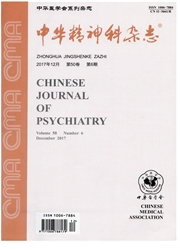

 中文摘要:
中文摘要:
目的观察重复经颅磁刺激(r TMS)联合帕罗西汀对创伤后应激障碍(PTSD)的疗效及安全性。方法将56例PTSD患者随机分为研究组(帕罗西汀联合r TMS治疗)28例和对照组(帕罗西汀治疗)28例,均治疗4周。于治疗前及治疗后第4周末采用创伤后应激障碍检查表(PCL)及汉密尔顿焦虑量表(HAMA)评定。结果两组治疗后第4周末PCL总分评分差及各因子分均较各自治疗前降低(P〈0.05),研究组PCL总分评分差及各因子评分差均高于对照组(P〈0.05);治疗后第4周末两组HAMA评分均较各自治疗前低(P〈0.05),研究组HAMA评分低于对照组(P〈0.05);两组间总不良反应发生率比较差异无统计学意义(P〉0.05)。结论联用r TMS能够增加帕罗西汀对PTSD的重现、回避、高警觉核心症状以及焦虑症状的疗效。
 英文摘要:
英文摘要:
Objective To observe the effect and safety of repetitive transcranial magnetic stimulation( r TMS) combined with paroxetine in the treatment of post-traumatic stress disorder( PTSD). Methods 56 patients with PTSD were randomized into study group( 28 cases) treated with r TMS combined with paroxetine and control group( 28 cases) treated with paroxetine monotherapy for 4 weeks. All patients in both groups were assessed with PTSD Checklist( PCL) and Hamilton Anxiety Rating Scale( HAMA) at baseline and at the end of the treatment. Results At the end of the 4-week treatment,total score and all factor scores of PCL in both groups decreased significantly when compared with the baseline( P〈0. 05). The decrease of total score and all factor scores of PCL in study group were significantly higher than those in control group( P〈0. 05). At the end of the treatment,total scores of HAMA in both groups were significantly lower than the baseline( P〈0. 05),and total score of HAMA in study group was significantly lower than that in control group( P〈0. 05). No significant difference was found in incidence rate of side effects between the two groups( P〈0. 05). Conclusion Combination with r TMS can enhance the effect of paroxetine on symptoms of flash-back,evasion,hyperarousal and anxiety in PTSD.
 同期刊论文项目
同期刊论文项目
 同项目期刊论文
同项目期刊论文
 The effect of citalopram on chronic stress-induced depressive-like behavior in rats through GSK3 bet
The effect of citalopram on chronic stress-induced depressive-like behavior in rats through GSK3 bet Quetiapine add-on therapy improves the depressive behaviors and hippocampal neurogenesis in fluoxeti
Quetiapine add-on therapy improves the depressive behaviors and hippocampal neurogenesis in fluoxeti Gastrodin Ameliorates Anxiety-Like Behaviors and Inhibits IL-1β Level and p38 MAPK Phosphorylation o
Gastrodin Ameliorates Anxiety-Like Behaviors and Inhibits IL-1β Level and p38 MAPK Phosphorylation o Antipsychotics promote the differentiation of oligodendrocyte progenitor cells by regulating oligode
Antipsychotics promote the differentiation of oligodendrocyte progenitor cells by regulating oligode Citalopram alleviates chronic stress induced depression-like behaviors in rats by activating GSK3 be
Citalopram alleviates chronic stress induced depression-like behaviors in rats by activating GSK3 be Electroconvulsive therapy improves antipsychotic and somnographic responses in adolescents with firs
Electroconvulsive therapy improves antipsychotic and somnographic responses in adolescents with firs Sensorimotor gating and memory deficits in an APP/PS1 double transgenic mouse model of Alzheimer&apo
Sensorimotor gating and memory deficits in an APP/PS1 double transgenic mouse model of Alzheimer&apo Anti-depressive mechanism of repetitive transcranial magnetic stimulation in rat: The role of the en
Anti-depressive mechanism of repetitive transcranial magnetic stimulation in rat: The role of the en Quetiapine and repetitive transcranial magnetic stimulation ameliorate depression-like behaviors and
Quetiapine and repetitive transcranial magnetic stimulation ameliorate depression-like behaviors and Gastrodin Alleviates Cerebral Ischemic Damage in Mice by Improving Anti-oxidant and Anti-inflammatio
Gastrodin Alleviates Cerebral Ischemic Damage in Mice by Improving Anti-oxidant and Anti-inflammatio Rosmarinic acid ameliorates PTSD-like symptoms in a rat model and promotes cell proliferation in the
Rosmarinic acid ameliorates PTSD-like symptoms in a rat model and promotes cell proliferation in the Atypical Antipsychotics Do Not Reverse Prepulse Inhibition Deficits in Acutely Psychotic Schizophren
Atypical Antipsychotics Do Not Reverse Prepulse Inhibition Deficits in Acutely Psychotic Schizophren Gastrodin ameliorates anxiety-like behaviors and inhibits IL-1beta level and p38 MAPK phosphorylatio
Gastrodin ameliorates anxiety-like behaviors and inhibits IL-1beta level and p38 MAPK phosphorylatio Microinjection of sanguinarine into the ventrolateral orbital cortex inhibits Mkp-1 and exerts an an
Microinjection of sanguinarine into the ventrolateral orbital cortex inhibits Mkp-1 and exerts an an Hyperbaric oxygen preconditioning ameliorates anxiety-like behavior and cognitive impairments via up
Hyperbaric oxygen preconditioning ameliorates anxiety-like behavior and cognitive impairments via up 期刊信息
期刊信息
